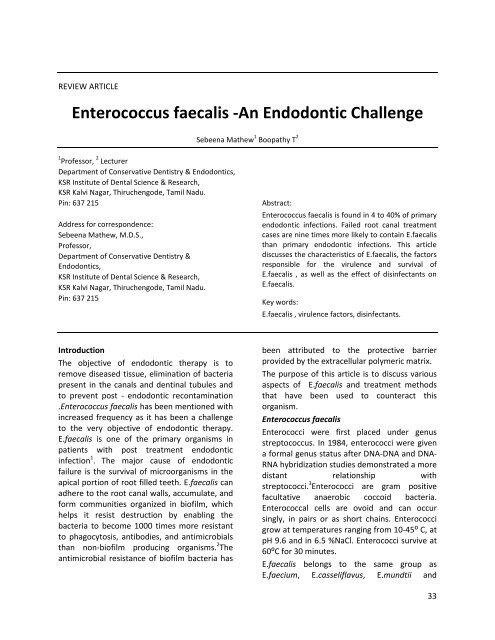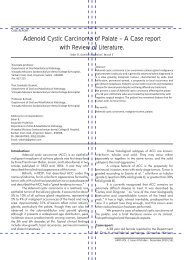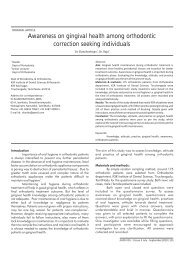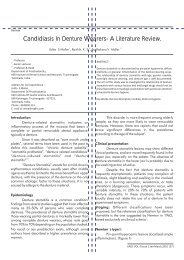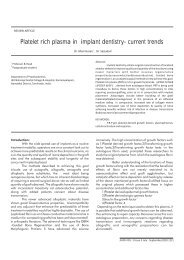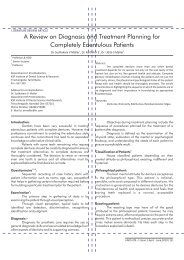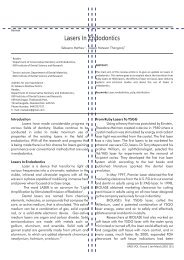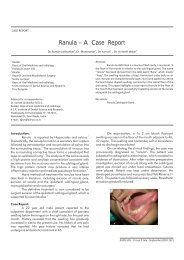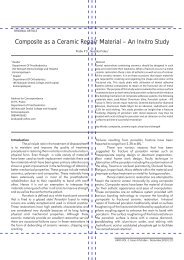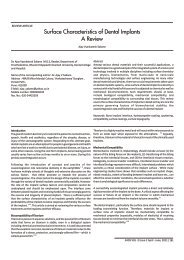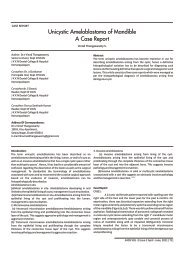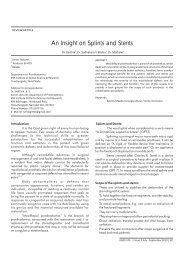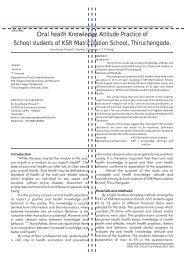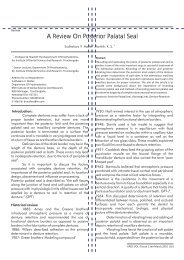Enterococcus faecalis -An Endodontic Challenge
Enterococcus faecalis -An Endodontic Challenge
Enterococcus faecalis -An Endodontic Challenge
You also want an ePaper? Increase the reach of your titles
YUMPU automatically turns print PDFs into web optimized ePapers that Google loves.
REVIEW ARTICLE<br />
<strong>Enterococcus</strong> <strong>faecalis</strong> -<strong>An</strong> <strong>Endodontic</strong> <strong>Challenge</strong><br />
1 Professor, 2 Lecturer<br />
Department of Conservative Dentistry & <strong>Endodontic</strong>s,<br />
KSR Institute of Dental Science & Research,<br />
KSR Kalvi Nagar, Thiruchengode, Tamil Nadu.<br />
Pin: 637 215<br />
Address for correspondence:<br />
Sebeena Mathew, M.D.S.,<br />
Professor,<br />
Department of Conservative Dentistry &<br />
<strong>Endodontic</strong>s,<br />
KSR Institute of Dental Science & Research,<br />
KSR Kalvi Nagar, Thiruchengode, Tamil Nadu.<br />
Pin: 637 215<br />
Introduction<br />
The objective of endodontic therapy is to<br />
remove diseased tissue, elimination of bacteria<br />
present in the canals and dentinal tubules and<br />
to prevent post - endodontic recontamination<br />
.<strong>Enterococcus</strong> <strong>faecalis</strong> has been mentioned with<br />
increased frequency as it has been a challenge<br />
to the very objective of endodontic therapy.<br />
E.<strong>faecalis</strong> is one of the primary organisms in<br />
patients with post treatment endodontic<br />
infection 1 . The major cause of endodontic<br />
failure is the survival of microorganisms in the<br />
apical portion of root filled teeth. E.<strong>faecalis</strong> can<br />
adhere to the root canal walls, accumulate, and<br />
form communities organized in biofilm, which<br />
helps it resist destruction by enabling the<br />
bacteria to become 1000 times more resistant<br />
to phagocytosis, antibodies, and antimicrobials<br />
than non-biofilm producing organisms. 2 The<br />
antimicrobial resistance of biofilm bacteria has<br />
Sebeena Mathew 1 Boopathy T 2<br />
Abstract:<br />
<strong>Enterococcus</strong> <strong>faecalis</strong> is found in 4 to 40% of primary<br />
endodontic infections. Failed root canal treatment<br />
cases are nine times more likely to contain E.<strong>faecalis</strong><br />
than primary endodontic infections. This article<br />
discusses the characteristics of E.<strong>faecalis</strong>, the factors<br />
responsible for the virulence and survival of<br />
E.<strong>faecalis</strong> , as well as the effect of disinfectants on<br />
E.<strong>faecalis</strong>.<br />
Key words:<br />
E.<strong>faecalis</strong> , virulence factors, disinfectants.<br />
been attributed to the protective barrier<br />
provided by the extracellular polymeric matrix.<br />
The purpose of this article is to discuss various<br />
aspects of E.<strong>faecalis</strong> and treatment methods<br />
that have been used to counteract this<br />
organism.<br />
<strong>Enterococcus</strong> <strong>faecalis</strong><br />
Enterococci were first placed under genus<br />
streptococcus. In 1984, enterococci were given<br />
a formal genus status after DNA-DNA and DNA-<br />
RNA hybridization studies demonstrated a more<br />
distant relationship with<br />
streptococci. 3 Enterococci are gram positive<br />
facultative anaerobic coccoid bacteria.<br />
Enterococcal cells are ovoid and can occur<br />
singly, in pairs or as short chains. Enterococci<br />
grow at temperatures ranging from 10-45⁰ C, at<br />
pH 9.6 and in 6.5 %NaCl. Enterococci survive at<br />
60⁰C for 30 minutes.<br />
E.<strong>faecalis</strong> belongs to the same group as<br />
E.faecium, E.casseliflavus, E.mundtii and<br />
33
E.gallinarum. E.<strong>faecalis</strong> ferments mannitol,<br />
sucrose, sorbitol and aesculin and grows on<br />
tellurite bood agar producing black colonies.<br />
E.<strong>faecalis</strong> posses a group D carbohydrate<br />
cell wall antigen called Lancefield antigen,<br />
which is an intracellular glycerol teichoic acid<br />
associated with the cytoplasmic membrane. The<br />
cell wall contains a large amount of<br />
peptidoglycan and teichoic acid. Peptidoglycan,<br />
a cross linked peptide sugar helps it to<br />
counteract osmotic pressure of the cytoplasm<br />
and provides cell wall strength and shape. It has<br />
a polysaccharide backbone of alternating Nacetyl<br />
glucosamine and N-acetylmuramic acids.<br />
Virulence and survival factors of E.<strong>faecalis</strong><br />
E.<strong>faecalis</strong> possesses certain virulence factors<br />
including lytic enzymes, Aggregation substance<br />
(AS), pheromones and lipoteichoic acid. 4<br />
Aggregation Substance. AS is a 37 KDa surface-<br />
localized protein, a plasmid- encoded adhesin.<br />
The adhesin mediates cell-cell contact which<br />
facilitates the plasmid exchange between<br />
recipient and donor strains. AS plays a role in<br />
the dissemination of plasmid –encoded<br />
virulence factors, protects against<br />
polymorphonuclear leukocyte or macrophage<br />
mediated killing and enhance the virulence by<br />
activating the quorum –sensing mode of<br />
cytolysin regulation.<br />
Surface protein esp. It is a large chromosome<br />
encoded surface protein which has multiple<br />
repeat motifs.A study by Toledo-Arana et al<br />
demonstrated that in the presence of the<br />
surface protein esp, hydrophobicity,biofilm<br />
formation and adherence to biotic surfaces<br />
were increased.<br />
Collagen -binding protein (Ace): It helps<br />
E.<strong>faecalis</strong> bind to collagen in dentin.<br />
Gelatinase and serine protease. E.<strong>faecalis</strong><br />
secretes proteases like gelatinase and serine<br />
protease.Their secretion is autoregulated<br />
through the fsr system.Gelatinase is a non<br />
plasmid-encoded metalloendopeptidase.Gelatinase<br />
contributes to bone<br />
resorption and degradation of dentin organic<br />
matrix,thus playing an important role in<br />
pathogenesis of periapical inflammation.Serine<br />
protease cleaves peptide bonds and was shown<br />
to contribute to the binding of E.<strong>faecalis</strong> to<br />
dentin.<br />
Cytolysin: It is a plasmid encoded toxin that is<br />
produced by beta-hemolytic E.<strong>faecalis</strong> isolates<br />
.Cytolysin lyses erythrocytes,<br />
polymorphonuclear neutrophils and<br />
macrophages,kills bacterial cells and may lead<br />
to reduced phagocytosis.<br />
Lipoteichoic acid (LTA):Lipoteichoic acid can be<br />
regarded as a molecule contributing to the<br />
virulence of E.<strong>faecalis</strong> through the facilitation<br />
of aggregate formation and plasmid<br />
transfer.LTA of E.<strong>faecalis</strong> was reported to be<br />
doubled in quantity during the viable but non<br />
culturable (VBNC) state suggesting a role for<br />
LTA during this period. 5<br />
Hyaluronidase (spreading factor) is considered<br />
to facilitate the spread of bacteria as well as<br />
their toxins through host tissues. The presence<br />
of microorganisms including E.<strong>faecalis</strong> in<br />
periapical lesions may also be related to the<br />
activity of a degrading bacterial enzyme such as<br />
hyaluronidase.<br />
Extracellular superoxide: It is associated with<br />
enterococcal virulence, and it has been shown<br />
that its production is significantly higher in<br />
invasive strains than in commensal isolates.<br />
Pheromones:Pheromones from E.<strong>faecalis</strong> are<br />
chemotactic for human neutrophils and triggers<br />
superoxide production. <strong>An</strong>tibiotic resistance<br />
and other virulence traits, such as cytolysin<br />
production can be disseminated among strains<br />
of E.<strong>faecalis</strong> via sex pheromone system.<br />
E.<strong>faecalis</strong> is a persister due to its ability to<br />
survive under harsh environmental conditions.<br />
It grows in high salt concentrations, wide<br />
temperature range and tolerates a broad pH<br />
range and starves until an adequate nutritional<br />
supply becomes available. Studies have shown<br />
that it might be serum delivered fluid from the<br />
periapical tissues which sustain the microbial<br />
flora. E.<strong>faecalis</strong> can enter the viable but non<br />
culturable (VBNC) state, a survival mechanism<br />
adopted by a group of bacteria when exposed<br />
to environmental stress and resuccitate upon<br />
returning to favourable conditions. It is small<br />
36
enough to invade the dentinal tubules and lives<br />
in the dentinal tubules.Collagen binding protein<br />
help it to bind to the dentin. E.<strong>faecalis</strong> has the<br />
ability to establish mono-infections in<br />
medicated root canals. The organism has the<br />
ability to acquire, accumulate and share<br />
extrachromosomal elements, encoding<br />
virulence traits, which help to colonize,<br />
compete with other bacteria, resist host<br />
defense mechanisms and produce pathological<br />
changes directly through the production of<br />
toxins or indirectly through the induction of<br />
inflammation.<br />
E.<strong>faecalis</strong> has the advantage of forming<br />
biofilms. Hence it has a certain degree of<br />
protection and homeostasis. Biofilms grow in a<br />
nutrient -deprived ecosystem as it concentrates<br />
trace elements and nutrients by physical<br />
trapping and electrostatic interaction. The<br />
bacterial cells residing in a biofilm<br />
communicate, exchange genetic materials and<br />
acquire new traits. This communication takes<br />
place by quorum sensing.<br />
E.<strong>faecalis</strong> resists intra canal medicaments like<br />
calcium hydroxide by maintaining pH<br />
homeostasis.<br />
E.<strong>faecalis</strong> as an endodontic biofilm.<br />
E.<strong>faecalis</strong> forms intracanal biofilms,periapical<br />
biofilms and biomaterial centered infection.<br />
Invitro experiments have revealed distinct<br />
stages of the development of E.<strong>faecalis</strong> biofilm<br />
on root canal dentin. In stage 1, E.<strong>faecalis</strong> cells<br />
adhered and formed microcolonies on the root<br />
canal dentin surface. In stage 2, they induced<br />
bacterial mediated dissolution of the mineral<br />
fraction from dentine substrate. This localized<br />
increase in calcium and phosphate ions<br />
promotes mineralization (or calcification) of the<br />
E.<strong>faecalis</strong> biofilm in stage 3. The mature biofilm<br />
structure formed after 6 weeks of incubation<br />
and showed signs of mineralization. The<br />
mineralized E.<strong>faecalis</strong> biofilm showed a<br />
carbonated –apatite structure as compared to<br />
natural dentin which had carbonated-florapatite<br />
structure. Dentin degradation occurred<br />
in a nutrient deprived state and has been<br />
observed to be a consequence of the<br />
interaction of bacteria and their metabolic<br />
products on dentine. E.<strong>faecalis</strong> biofilm has<br />
been observed in root canal obturating<br />
materials (biomaterial centered infection).<br />
Disinfectants and E.<strong>faecalis</strong><br />
Studies have shown that 3% to full strength<br />
sodium hypochlorite (NaOCl) is effective for all<br />
presentations of E.<strong>faecalis</strong> including its<br />
existence as a biofilm.<br />
However, many of the studies about the<br />
antibacterial effect of NaOCl against root canal<br />
bacteria are in vitro studies, in either “neutral”<br />
test tube conditions, in root canals of extracted<br />
teeth, or in dentine blocks infected with a pure<br />
culture of one organism at a time. EDTA<br />
(Ethylene diamine tetraacetic acid) when used<br />
along with NaOCl is effective in removing the<br />
inorganic portion of the dentin. Smear layer<br />
removal provides access of irrigants to the<br />
dentinal tubules.<br />
0.1% sodium benzoate solution added to 10%<br />
citric acid solution will increase the chances of<br />
killing E.<strong>faecalis</strong>.<br />
A 2-min rinse of 2% chlorhexidine liquid can be<br />
used to remove E.<strong>faecalis</strong> from the superficial<br />
layers of dentinal tubules up to 100 µm. 2%<br />
chlorhexidine gel is effective at completely<br />
eliminating E.<strong>faecalis</strong> from dentinal tubules for<br />
15 days.<br />
Maria Teresa et al observed in their studies<br />
that it was not possible to eradicate E.<strong>faecalis</strong><br />
biofilms using chlorhexidine alone. 6 They found<br />
that the alternating use of chlorhexidine and<br />
cetrimide (0.1% and 0.05%) killed 100% of<br />
E.<strong>faecalis</strong> biofilm cultures. Cetrimide when<br />
used destructures the EPS (Extra polymeric<br />
substance) matrix. There after, chlorhexidine<br />
was able to react more directly on E.<strong>faecalis</strong>,<br />
possibly exerting its bactericidal potential to a<br />
greater degree.<br />
Orstavik D and Haapasalo M concluded from<br />
their study that 2% / 4% Iodine, potassium<br />
iodide (IKI) appeared as a more potent irrigant<br />
than sodium hypochlorite and chlorhexidine.<br />
37
MTAD (a mixture of tetracycline isomer,acid<br />
and detergent):MTAD is a formulation of<br />
doxycycline, citric acid and Tween 80. Its<br />
effectiveness is attributed to its anticollagenase<br />
activity, low pH and ability to be gradually<br />
released overtime. Mahmoud Torabinejad et al<br />
observed that MTAD is effective against<br />
E.<strong>faecalis</strong> . 7 MTAD is beneficial for retreatment<br />
cases as well.<br />
In one study a combination of calcium<br />
hyrdroxide and camphorated<br />
paramonochlorophenol completely eliminated<br />
E.<strong>faecalis</strong>.Metapex (a silicone oil-based calcium<br />
hydroxide paste containing 38% iodoform),<br />
more effectively disinfected dentinal tubules<br />
infected with E.<strong>faecalis</strong> than calcium hydroxide<br />
alone. 2% chlorhexidine gel when combined<br />
with calcium hydroxide achieves a pH of 12.8<br />
and can completely eliminate E.<strong>faecalis</strong> within<br />
dentinal tubules. Chlorhexidine and calcium<br />
hydroxide when combined together have<br />
shown better antimicrobial properties than<br />
calcium hydroxide alone. 8<br />
Nair, et al suggested the need of non antibiotic<br />
chemomechanical measures to treat teeth with<br />
infected and necrotic root canals so as to<br />
disrupt the biofilm.<br />
Er:Cr:YSGG laser employing radially emitting<br />
laser tips demonstrated a considerable effect<br />
on bacterial reduction within dentinal tubules<br />
of root canal infected with E.<strong>faecalis</strong>. 9<br />
Roth 811 sealer ,a zinc –oxide eugenol based<br />
sealer has been shown to exert antibacterial<br />
activity against E.<strong>faecalis</strong>.AH Plus (epoxy resin<br />
based sealer) and Grossman’s sealer are<br />
effective in killing E.<strong>faecalis</strong> within infected<br />
dentinal tubules.<br />
Steps that can be considered towards the<br />
elimination and prevention of E.<strong>faecalis</strong>:<br />
Treatment regimens should aim at prevention<br />
and elimination of E.<strong>faecalis</strong> during treatment,<br />
inbetween appointments and after completion<br />
of treatment. We can prevent its re-entry by<br />
following certain norms. That includes,<br />
ensuring that the patient rinses with 0 .2%<br />
chlorhexidine prior to the treatment,<br />
disinfecting the tooth and rubber dam with<br />
chlorhexidine or sodium hypochlorite and<br />
disinfecting gutta-percha points with sodium<br />
hypochlorite before insertion in the canal.<br />
Besides the above norms the following can be<br />
followed:<br />
1. Adequate apical preparation<br />
2. Use of canal irrigants such as 6 % sodium<br />
hypochlorite, 17% EDTA and 2% chlorhexidine 4<br />
3. Use of intracanal medicaments such as 2%<br />
chlorhexidine gel or 2% chlorhexidine gel<br />
+calcium hydroxide<br />
4. Consider AH plus or Grossman’s sealer.<br />
5. Proper coronal seal should be given.<br />
Conclusion:<br />
Numerous studies have been conducted on the<br />
effects of various disinfectants on E.<strong>faecalis</strong>.<br />
Most of them have been invitro. Clinically<br />
E.<strong>faecalis</strong> still poses to be a challenge.<br />
Endodontists studying root canal infections<br />
need to include endodontic clinical isolates of<br />
E.<strong>faecalis</strong> to analyze the properties of these<br />
strains which includes putative virulence factors<br />
or antibiotic resistance genes. 10 In order to<br />
develop methods of eradicating E.<strong>faecalis</strong> from<br />
persistent root canal infections, the mechanism<br />
through which this organism maintains these<br />
infections must be understood. 11<br />
References<br />
1. Shrestha A, Shi Z ,Neoh K G , Kishen A .<br />
Nanoparticulates for antibiofilm<br />
Treatment and effect of aging on its<br />
antibacterial activity. J Endod. 2010; 36<br />
(6) :1030-5.<br />
2. Liu H, Ling J,Wang W ,Huang X. Biofilm<br />
formation capability of <strong>Enterococcus</strong><br />
<strong>faecalis</strong> cells in starvation phase and its<br />
susceptibility to sodium hypochlorite. J<br />
Endod. 2010 ;36 (4): 630-5.<br />
3. Portenier I,Waltimo TMT ,Haapasalo M.<br />
<strong>Enterococcus</strong> <strong>faecalis</strong>-the root canal<br />
survivor and ‘star’ in post treatment<br />
disease. <strong>Endodontic</strong> Topics. 2003; 6:<br />
135-59.<br />
36
4. Stuart CH, Schwartz S A, Beeson T J,<br />
Owatz C B-<strong>Enterococcus</strong> <strong>faecalis</strong>: Its<br />
role in root canal treatment failure and<br />
current concepts in retreatment. J<br />
Endod. 2006 ; 32( 2 ):93-8.<br />
5. Kayaoglu G, Orstavik D-Virulence<br />
factors of <strong>Enterococcus</strong> <strong>faecalis</strong>:<br />
relationship to endodontic disease. Crit<br />
Rev Oral Biol Med. 2004 ;15(5): 308-20.<br />
6. Arias-Moliz MT , Ferrer-Luque C M,<br />
Gonzalez-Rodriguez M P, Valderaama M<br />
J , Baca P- Eradication of <strong>Enterococcus</strong><br />
<strong>faecalis</strong> biofilms by cetrimide and<br />
Chlorhexidine. J Endod. 2010;36 (1):87-<br />
90.<br />
7. Torabinejad M, Shabahang S,Aprecio<br />
RM, Kettering JD-The antimicrobial<br />
effect of MTAD-an in vitro investigation.<br />
J Endod. 2003;29 (6):400-3.<br />
8. Delgado R J, Gasparoto T H, Sipert C R,<br />
Pinheiro C R, Moraes I G, Garcia R B,<br />
Bramante C M, Campanelli AP ,<br />
Bernardineli N.-<strong>An</strong>timicrobial effects of<br />
Calcium hydroxide and Chlorhexidine<br />
on <strong>Enterococcus</strong> <strong>faecalis</strong>. J Endod.<br />
2010;36 (8):1389-93.<br />
9. Gordan W, Atabakhsh VA, Meza F,<br />
Doms A,Nissan R, Rizoiu L, Stevens R H-<br />
The antimicrobial efficacy of erbium,<br />
chromium: yttrium-scandium- galliumgarnet<br />
laser with radical emitting tips<br />
on root canal dentin walls infected with<br />
E.<strong>faecalis</strong>. J Am Dent Assoc.<br />
2007;138(7):992-1002.<br />
10. Al-Ahmad A, Maier J, Follo M,<br />
Spitzmuller B, Wittmer A, Hellwig E,<br />
Hubner J, Jonas D- Food-borne<br />
Enterococci integrate into oral biofilm:<br />
<strong>An</strong> in vivo study. J Endod. 2010<br />
;36(11):1812-19.<br />
11. Estrela C,Sydney GB,Figueiredo JA,<br />
Estrela CR.<strong>An</strong>tibacterial efficacy of<br />
intracanal medicaments on bacterial<br />
biofilm:a criticalreview. J Appl Oral<br />
Sci.2009;17(1):1-7.<br />
37


